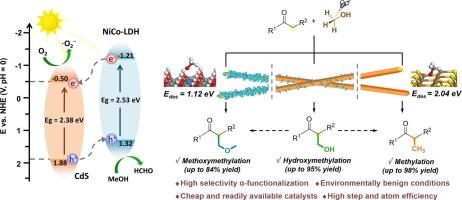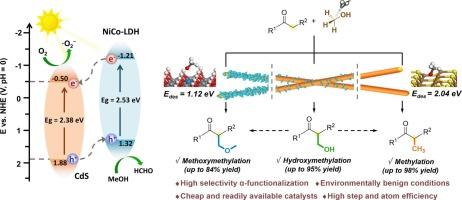利用甲醇作为C1源在cds光催化剂上实现可调碳氢功能化
IF 6.5
1区 化学
Q2 CHEMISTRY, PHYSICAL
引用次数: 0
摘要
通过单一催化体系从相同的起始材料实现多种分子支架的发散合成代表了有机转化的一个迷人但具有挑战性的前沿。在此,我们提出了一种多相光催化策略,利用甲醇作为绿色和可再生的C1原料来解锁可调节的α-C(sp3)-H功能化酮,包括α-羟甲基化,α-甲氧基甲基化和α-甲基化。通过简单地调节反应温度和NiCo-LDH助催化剂的负载,可以精确控制产物的选择性,三种途径的产率高达98%。气-液-固分段流(PGSF)系统可实现有效的过程强化,并具有显著的周转量(TON) 31591的克级可扩展性。结合原位表征和DFT计算的机理研究表明,NiCo-LDH的加入可以调节CdS的电子性质,抑制甲醇过氧化,提高α-羟甲基化效率,同时调节反应中间体的脱附动力学,从而指导α-甲氧基甲基化和α-甲基化反应的选择性。该策略为甲醇激活的发散碳氢功能化建立了一个强大的平台,有望为半导体催化有机合成开辟新的前景。本文章由计算机程序翻译,如有差异,请以英文原文为准。


Harnessing methanol as a C1 source for tunable C–H functionalization over CdS-based photocatalysts
Achieving divergent synthesis of multiple molecular scaffolds from identical starting materials via a single catalytic system represents a fascinating yet challenging frontier in organic transformation. Herein, we present a heterogeneous photocatalytic strategy that leverages methanol as a green and renewable C1 feedstock to unlock tunable α-C(sp3)-H functionalization of ketones, including α-hydroxymethylation, α-methoxymethylation, and α-methylation. By simply modulting reaction temperature and NiCo-LDH co-catalyst loading, precise control over product selectivity is achieved, with yields up to 98% across three pathways. A gas–liquid-solid segmented flow (PGSF) system enables effective process intensification alongside demonstrated gram-scale scalability with a remarkable turnover number (TON) of 31591. Mechanistic investigations integrating in-situ characterization and DFT calculations revealed that NiCo-LDH incorporation tailors CdS electronic properties to suppress methanol overoxidation, enhancing α-hydroxymethylation efficiency, while modulating the desorption kinetics of reactive intermediates, thereby directing the reaction selectivity between α-methoxymethylation and α-methylation reaction. This strategy establishes a robust platform for methanol-enabled divergent C–H functionalization, expecting to open up new prospects for semiconductor-catalyzed organic synthesis.
求助全文
通过发布文献求助,成功后即可免费获取论文全文。
去求助
来源期刊

Journal of Catalysis
工程技术-工程:化工
CiteScore
12.30
自引率
5.50%
发文量
447
审稿时长
31 days
期刊介绍:
The Journal of Catalysis publishes scholarly articles on both heterogeneous and homogeneous catalysis, covering a wide range of chemical transformations. These include various types of catalysis, such as those mediated by photons, plasmons, and electrons. The focus of the studies is to understand the relationship between catalytic function and the underlying chemical properties of surfaces and metal complexes.
The articles in the journal offer innovative concepts and explore the synthesis and kinetics of inorganic solids and homogeneous complexes. Furthermore, they discuss spectroscopic techniques for characterizing catalysts, investigate the interaction of probes and reacting species with catalysts, and employ theoretical methods.
The research presented in the journal should have direct relevance to the field of catalytic processes, addressing either fundamental aspects or applications of catalysis.
 求助内容:
求助内容: 应助结果提醒方式:
应助结果提醒方式:


